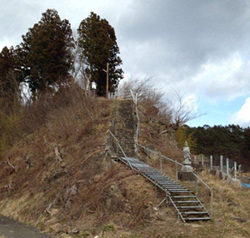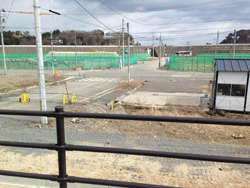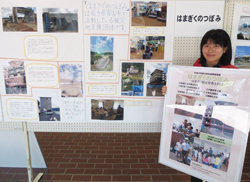Top>HAKUMON Chuo [2015 Summer Issue]>Supporting Disaster-affected Areas Photo Exhibition
 Index
Index
Chuo University News

Severely bent handrail on the evacuation route
Chuo University Volunteer Center
Supporting Disaster-affected Areas
Photo Exhibition
May 12 to 14, 2015, Central Library, 1F Exhibition Space
Chuo University Volunteer Center
Coordinator, Mariko Matsumoto
Four years have passed since the Great East Japan Earthquake. The affected areas along the Tohoku coast are no longer reported on as frequently on the TV or in newspapers. However, these areas are still a long way from recovery, and it is important to continue to provide support without allowing it to fade away.
At Chuo University, since 2011 there have been five student organizations helping support disaster-affected areas, with students volunteering mainly for the Tohoku coastal region, and they have worked on a variety of initiatives in order to help as much as they can with recovery. Mostly they travel to the area during a long vacation, and have been active in Iwate and Miyagi.
A photo exhibition was held so people could see the current state of disaster-affected areas which the students saw and the activities of the students, and think about the affected areas. Even if the areas and people they work with are different, by looking at the exhibition of the five groups you could see that marks of the disaster remain in those areas. With people unable to live without concern, in such a difficult environment, you could see that they looked forward to the Chuo University students’ arrival.
Activities will also be carried out in summer, winter and spring for the 2015 school year. I would like as many Chuo University students as possible to learn about the current state of the disaster-affected areas and think about what they can learn from there as it involves them personally.
Learning from Taro, a Town with Tsunami Protection
Hanagiku no Tsubomi Representative, 2nd Year Law Student, Saori Yoshida
Miyako, in Iwate, where we go for our volunteer activities, was also damaged by tsunami in the Meiji and Showa periods, but it has recovered every time. In particular, the Taro area learned from past events and focused on building a town focusing on disaster prevention, both in education and physical layout.
The famous “Great Wall” levees were 10 meters high and over 2.5 kilometers long.

“Cutting corners” at an intersection, improving visibility for quicker evacuation
Efforts were made with the layout to make it easy to evacuate. One such effort was “cutting corners”. The external corners of the premises were eliminated at road intersections in order to provide greater visibility and make it easier to turn corners. This made it possible to evacuate safely and quickly, and the increased visibility also made it easier for people to communicate and help each other.
The town was also arranged in a checkerboard pattern, making it possible to evacuate straight to higher ground no matter where someone was in town. The side of town with mountains had a number of evacuation routes leading up to higher ground, allowing faster evacuation. However, seeing how the handrail for this evacuation route is bent badly, it should indicate the force of the tsunami and how unprepared for the height of the tsunami they were. The tsunami destroyed the “Great Wall” as well, passing beyond it. This handrail is one of the marks left behind by the Great East Japan Earthquake’s tsunami. Even four years after the disaster, these kinds of marks still remain. This is the reality.
The passage of time seems different between the four years that have passed in Tokyo, where the media is reporting less and less about the disaster, and the four years in those areas affected by disaster that are still trying to recover. I feel that is what they are trying to tell us.

Ms. Saori Yoshida, who learned in the affected areas
In the Taro region in 2003, eight years before the Great East Japan Earthquake, a “Town of Tsunami Prevention Declaration” was made, with efforts being made for evacuation training and disaster prevention education for children, who made Karuta cards for tsunami prevention, and also efforts to have people pass on memories of previous tsunami. Enhancement on the physical side to protect against natural dangers has its limits, and also leads to people letting their guards down. In reality, during the Great East Japan Earthquake there were people who were overconfident because the levee existed, and so some of them did not evacuate.
In Tokyo, far from these areas affected by disaster, what can we do? I believe the important thing is not to let memories fade. With the decision to hold the 2020 Olympics and Paralympics in Tokyo, more and more construction workers are leaving the disaster-affected areas, and recovery plans are not proceeding. In this situation, learning about the current state of affected areas and not forgetting the disaster will help increase disaster prevention awareness. I believe this is an important first step.
<Introduction of Organizations>
- Hamarainya
- [Active Area]
Temporary housing at Omose Junior High School, Kesennuma, Miyagi - [Activity Details]
On March 11 we held a memorial ceremony at the meeting area, together with residents of the temporary housing. Our group’s philosophy is to “become strength to live today” for the local people, and we hold tea parties and radio gymnastic exercise sessions to reassure residents and help build local bonds. - Omose Learning Support
- [Active Area]
Omose Elementary School district, Kesennuma, Miyagi - [Activity Details]
The group holds experiential learning activities about the area for the children of Omose Elementary School, so that the future generation that will support the area will grow up healthy. This March, we had a picnic from downstream to upstream along the Omose River, and discovered a lot of flowers and insects. - Team Jigen
- [Active Area]
Oshima and Shishiori districts in Kesennuma, Miyagi - [Activity Details]
Oshima has a lot of fishers, and so we helped with fishing such as by repairing nets or washing scallop shells. In Shishiori, we helped out people in the temporary shopping district, and made playground equipment for the nearby park. Through these activities, I grew to like Oshima and Kesennuma, and would like to increase the number of people who continue to go to Tohoku. - Team Onagawa
- [Active Area]
Onagawa Town, Oshika District, Miyagi - [Activity Details]
The group holds study tours so people can see the reality of disaster-affected areas themselves and learn lessons of the disaster from local residents. Four years have passed since the disaster as of March, and Onagawa Station has finally reopened as well as having the traffic circle in front of the station completed. By speaking in the Tama region about these things we learned in affected areas, we would like to contribute to disaster prevention awareness and keeping the disaster-affected areas fresh in people’s minds in Tama.
- Research Activities as a Member of Research Fellowship for Young Scientists (DC1), Japan Society for the Promotion of Science (JSPS) Shuma Tsurumi
- Important Factors for Innovation in Payment Services Nobuhiko Sugiura
- Beyond the Concepts of Fellow Citizens and Foreigners— To Achieve SDGs Goal 10 “Reduce Inequality Within and Among Countries” Rika Lee
- Diary of Struggles in Cambodia Fumie Fukuoka
- How Can We Measure Learning Ability?
—Analysis of a Competency Self-Assessment Questionnaire— Yu Saito / Yoko Neha - The Making of the Movie Kirakira Megane








